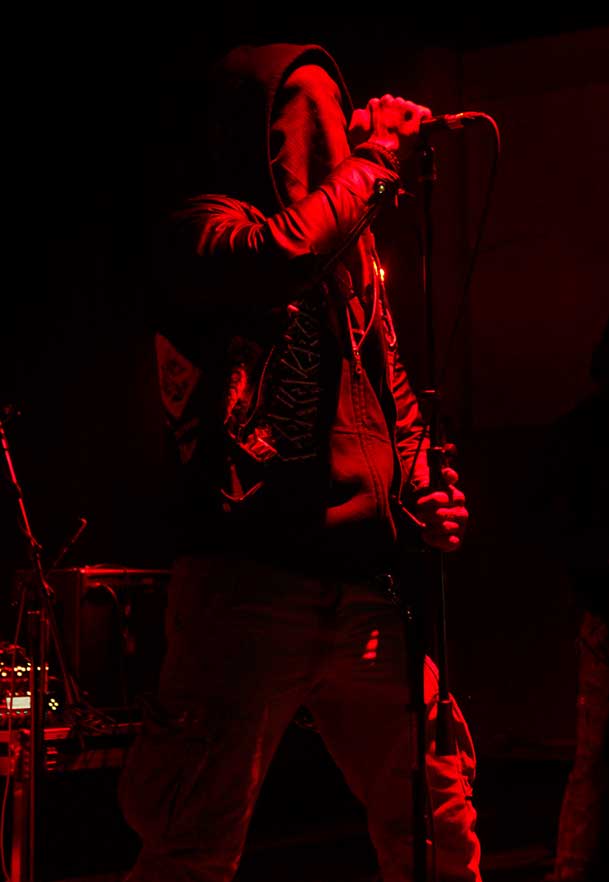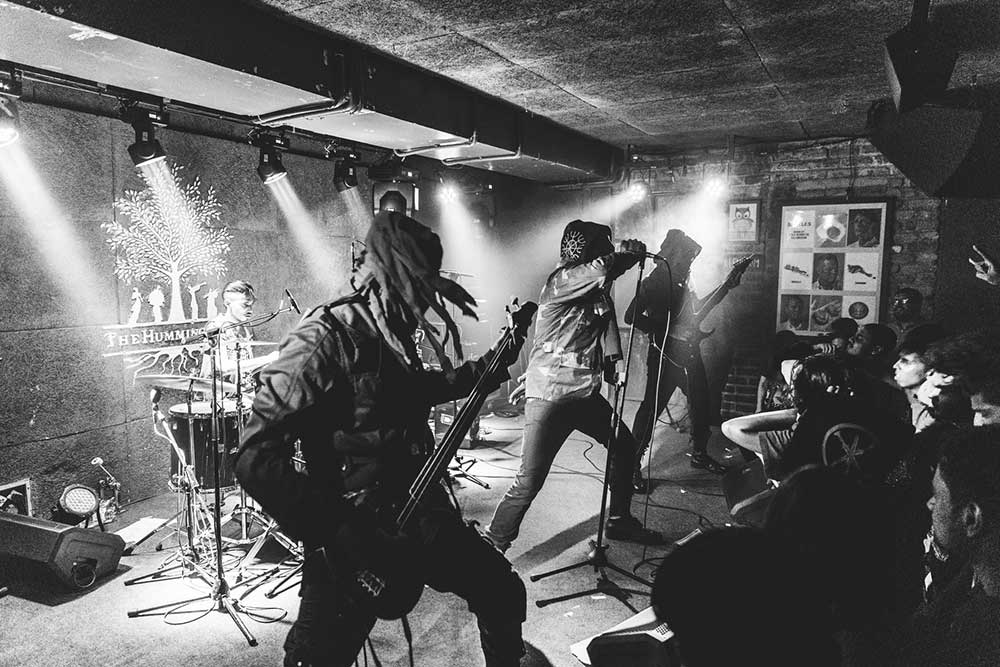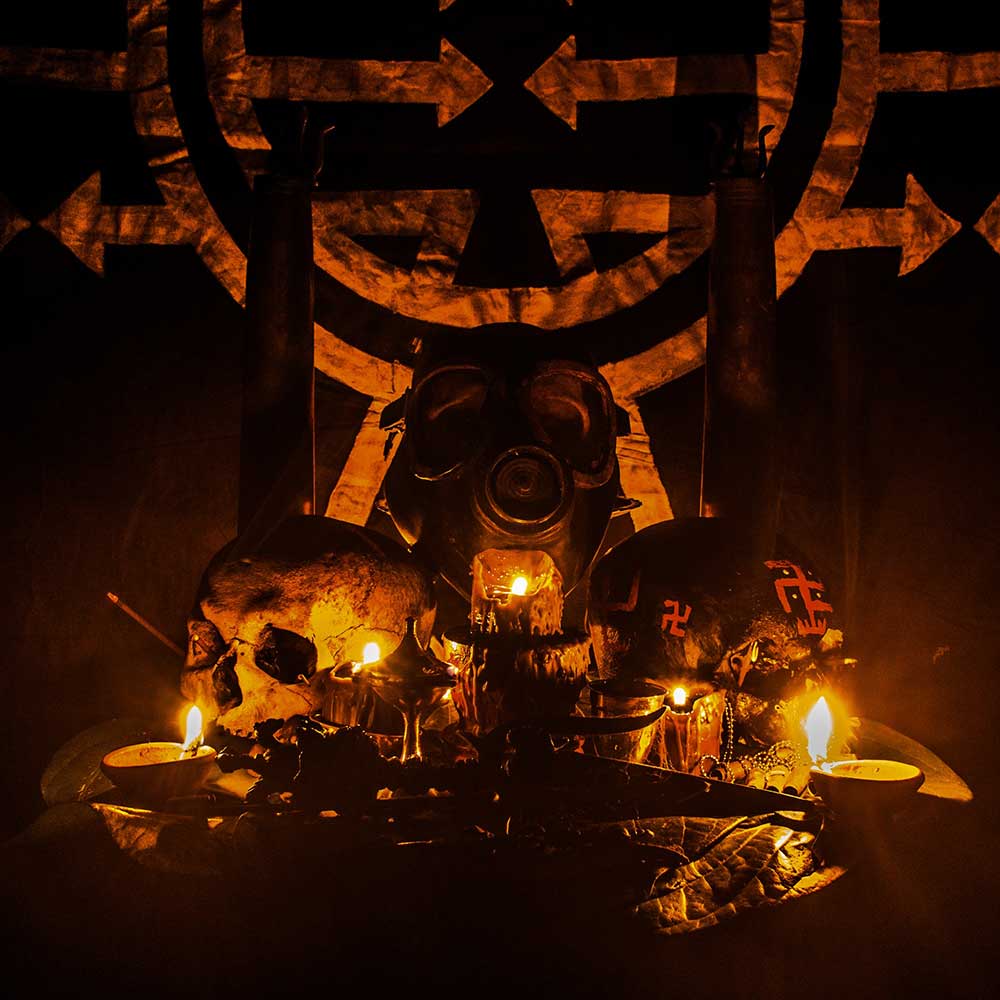Genocide Shrines
2019-10-16
by Niklas Göransson
Born out of third-world chaos and fuelled by the creed of ancestors – Sri Lankan death/black underground guerrilla Genocide Shrines refuse to cower before terror and oppression.
– Conceptually, this split is a continuation of our foundational themes. Ever since the 2015 full-length, “Manipura Imperial Deathevokovil”, we’ve been delving further into concepts such as death, Shunyaism, and the individual’s search for ultimate truth – some of which stem from the philosophies of Theravada Buddhism. After meeting with N from HERESIARCH in the flesh, we realised the many similarities between the philosophical aspects of our respective bands and so decided to let this split release stand as a testament to our collective agendas. We’d already been in touch for years; N was one of the few people to whom GENOCIDE SHRINES was unofficially presented during the times of our inception. He later introduced us to Patrick from Iron Bonehead, who’s now released vinyl versions of most of our past work.
Featuring also fellow Sri Lankans SERPENTS ATHIRST as well as New Zealand’s TREPANATION, “Scorn Coalescence” is a four-way split released on CD by Cyclopean Eye Productions – an Indian underground operation whose first-ever release was GENOCIDE SHRINES’ 2012 “Devanation Monumentemples” EP – and on vinyl by American label Dark Descent Records.
– The core remains the same – it’s still BWG Nawarathne and I dictating all aspects of composition and overall sound, with hand-picked contributions from our session members. In the past, we’ve had to use new studios with completely different equipment for every release but, by now, I believe us to have attained some stability in terms of our consistency of sound.
The result is a ferociously heavy take on the classic style of Southeast Asian savagery, as pioneered by the likes of Singapore’s ABHORER. But, while GENOCIDE SHRINES firmly embody the region’s characteristic vitriol, some of their material also has a hypnotic and almost trance-like quality.
– We are indeed followers of old cults such as ABHORER, SURRENDER OF DIVINITY, and IMPIETY. The violent and corrupt third-world environment shaping the extremity of sound is reflected in bands such as BARZAK and ORATOR from Bangladesh, ZYGOATSIS and NOCTURNAL DAMNATION from Thailand, NECHBEYTH and DEVOURER from Singapore, UGRA KARMA from Nepal, NEBIRAS from Malaysia, GRUESOME MALADY from India, PLECTO ALIQUEM CAPITE from Sri Lanka, and so on. Musically, our influences are apparent to the trained ear but there are traditional scales in the compositions taking us far away from common generalisations. Even though we are fans of classical Sri Lankan and Indian music, I must say that black and death metal are the ideal vehicles for carrying our message – mostly due to their potential for exploring and accommodating fringe territories and ideas.

My interviewee, GENOCIDE SHRINES frontman C Trident, is not only a musician but also an active concert promoter and label manager.
– I operate a DIY project known as Raavan Kommand, which we use to collectively organise our own gigs. I also print small batches of demo tapes from new bands that interest me and then use them to distribute the music and merchandise of several projects I’m involved in, all from varying genres within the extreme ends of the metal spectrum. But this is only a small-scale venture without long-term plans since certain blocks imposed by the government mean I can only operate within Sri Lanka and not distribute overseas.
Are there any metal stores over there?
– None. The cultural stigma around this type of music still exists and the die-hards are not all that many, so opening up a record store dedicated to metal would, unless you have the money and resources to burn, essentially mean financial suicide. Sri Lankan metal has been building up steadily since the 70s but only developed into an actual independent scene in the late 90s. Still to date there are no dedicated metal stores, bars, or even pubs that play rock music. None of the radio stations would ever touch anything remotely metal related. Even though we have multitudes of ‘pop stars’ peddling utter garbage passed off as ’rock music’, the real underground operates independently along with its circle of about one hundred ardent followers.
Bardo Methodology has seen plenty of discussions about the 90s and early 00s scenes from various European countries, where underground gigs would often entail a healthy portion of drunken mayhem and violence. For many of those fortunate enough to spend formative years in this milieu, that hostile atmosphere came to define the entire feeling around black metal – something decidedly missing from concerts today. Now, given how carnage and calamity would’ve been part of any Sri Lankan metalheads daily life well before they even discovered the music, I suspect things are slightly different over there. When growing up surrounded by mass-murder and sectarian violence on a pretty epic scale, stirring up trouble at the rare gatherings of metalheads might not be of utmost priority.
– Well noted, you suspected quite correctly. Even though the scene is relatively new compared to Europe, there’s less violence at shows than we ideally would have. Death, destruction, political and religious corruption, hunger and poverty – we bear all the hallmarks of a conflict-ridden third-world country. So, naturally, these things tend to occupy our concerns more than simple drunken violence at shows. Just a few months back, Sri Lanka was barely recovering from a thirty-year civil war when the Easter Attack terrorists brought our country back into a state of emergency; more army checkpoints, crooked politicians, paramilitary groups, enforced disappearances, racial tensions, media and information corruption, and so on.
On April 21, 2019 – in the midst of Easter Sunday celebrations – suicide bombers targeted three churches around the Sri Lankan capital of Colombo. Later during the same day, similar attacks were carried out against three luxury hotels as well as two civilian targets in other parts of the country. The State Intelligence Service would later claim to have successfully diffused a second wave of terror. A local Islamist organisation with alleged ties to foreign outfits claimed responsibility for the attack, which left 259 people dead and many more wounded.
– Raavan Kommand almost had to cancel a gig scheduled shortly after the Easter Attacks. Ethnic conflicts were on the rise and there was information about more imminent attacks – raids took place all over the island, military checkpoints were everywhere and security in Colombo tightened up harder than ever. However, the collective involved decided to proceed as planned, giving many other event organisers the determination to push forward and return the country back to normalcy; refusing to be ’terrorised’.
Hosting underground metal events in a country rife with religious tension would at least provide some added excitement. As much as we’ve heard about black metal cancellations around Europe, Australia, and the US, one would have to assume that all of it pales in comparison to what Raavan Kommand and their cohorts are forced to deal with.
– Of course, we come from a dangerously conservative culture and have had many threats from political and paramilitary groups. Although there have been certain power fluctuations following changes in government, the threat to free speech and art is still present but under different contexts than what the Western world is currently going through. This is why we’ve been forced to keep our activities low-key. We’ve had many cases of White Van-enforced disappearances and summary executions, which tends to happen to people whom the governing authorities or religious groups deem a ‘threat’.
A 1999 study by the United Nations placed Sri Lanka second in the world for state-facilitated disappearances, with security forces having detained an estimated 12,000 citizens since the beginning of the Sri Lankan Civil War. ‘White vanning’ has since become a common euphemism for government-sponsored kidnappings; there’s even a 2015 documentary about the phenomenon called White Van Stories.
– Until recently the White Van was just an urban legend based on eyewitness accounts of plain-coloured vans observed in the vicinity of where people had been abducted, after which the individuals were rarely seen again – either dead or alive. This has happened to many, including media personnel. The few court cases which are pursued usually end up dismissed due to lack of evidence or outright silencing of people who could reveal information.

You have performed in neighbouring countries several times – is there much of a difference between local scenes throughout the region?
– Definitely. India itself, being a bigger country, contains several independent scenes; all with stark differences. Countries such as Indonesia, Japan, and India have corporate sponsors backing big festival-size events and artists, while underground stalwarts such as the Bangalore Doom Syndicate – run by Sandesh of Cyclopean Eye and Vikram Bhat of the legendary DYING EMBRACE – or Hellion Distro and Putrid Ascendancy from Kolkata do things independently. The region now has a very strong and independent underground subculture, mostly thanks to maniacs such as Whathayakorn from SURRENDER OF DIVINITY and Incoffin Productions as well as Shyaithan from IMPIETY and DEVOURER.
The Thai scene especially has emerged as a strong and active one in recent years, with Bangkok-based Incoffin Productions having brought over bands such as MARDUK, WATAIN, ANGELCORPSE, BLASPHEMY, SABBAT, ARCHGOAT, and POSSESSED.
– Promoters in countries such as Malaysia and Singapore also host big names, doing everything themselves with the support of some die-hard followers. Scenes in the lesser developed countries face even more threats to their existence due to the highly conservative and corrupted third-world environments they emerged from, where such activities could easily see you thrown in jail without explanation. I know some guys in Nepal and Pakistan who were arrested simply for organising events of this sort.
In the summer of 2016, GENOCIDE SHRINES were scheduled to assail Europe – including a number of festivals such as Under the Black Sun and Chaos Descends. Unfortunately, with only a few weeks to go, the entire tour was cancelled.
– This was a case of our visas being rejected – naturally aligned with all remaining factors I mentioned. As a result of our government’s poor international relations, Sri Lankan passports are one of the lowest ranked in the world. This has resulted in many Western governing agencies requiring extensive documentation to meet their criteria for legit travellers and tourists. Since the local agencies here have never dealt with artists going overseas on tours and such, they were unable to advise us properly so we couldn’t meet the visa demands in time. Back then, a few of us had never before travelled to any of the major continents such as North America, Australia, or Europe. Our personal financial situations were another fact which somehow cautioned the visa agencies that we shouldn’t be permitted to travel, due to the risk we pose of not returning back home again. Fair enough, to a certain extent. Needless to say, all the involved promoters did everything in their power to support us until the last minute. We’ve now finally rectified most of the issues we faced during our last attempt and are actively talking with trusted and interested parties to try again in 2020. Since then, I’ve finally visited Europe myself; last year, when I attended Never Surrender in Berlin, Germany.
What was your first impression of the European underground scene?
– It was all I’d heard and read about and definitely a little more! I’d wanted to visit shows in Europe for many years but nothing ever materialised. It wasn’t until 2017 I figured out a few things and, due to costs involved, planned it for an entire year ahead. To take maximum advantage of my opportunity, I’d also initially planned to visit gigs in Czech Republic and Poland but, unfortunately, since it was my first application into the Schengen area they only granted me permission for seven days. Nevertheless, this was more than worth it for me. I saw BLASPEHMY when they played in Thailand a month earlier so I got to meet the Ross Bay death dealers for the second time and continued some great conversations with Black Winds, Ryan Förster, and Eduardo from Brazilian Ritual Records… then got drunk with Riyo Kitamura from EVIL and Mr Bukkake Boy of GUT and CHAOS CASCADE. I also met some old contacts in the flesh for the first time: Bernd from Dunkelheit Productions, Patrick from Iron Bonehead, as well as Roman artist Silvia Palmeroni who’s done paintings for some of my other work. Thanks to our label boss, Sandesh of Cyclopean Eye – who was also kind enough to help me plan my visit – I was introduced to maniacs from around the world and remember being surprised to have met people of so many nationalities, all in the same night! I was quite occupied with keeping myself hydrated with all the killer beer and talking to people who wanted to purchase merchandise; I brought a few patches and records with me, because Sandesh had shared the fact that I was attending the fest so people had pre-ordered certain GENOCIDE SHRINES items.
That line-up must have been pretty wild for any underground fanatic who’s never been able to attend shows in Europe or the States before.
– It was absolutely wild because, due to my travel restrictions, I haven’t seen all that many bands live before. I watched every set I possibly could, noting how professionally organised the event was, with plenty of time to inspect the audio equipment used by bands and engineers. Highlights included watching BLASPHEMY for the second time, NECROHOLOCAUST, LIHHAMON – especially when Ryan Förster joined the stage for a CONQUEROR song… then REENCARNACIÓN, GRAVE UPHEAVAL, SABBAT, VASSAFOR, POSSESSION, RITUALIZATION, IRKALLIAN ORACLE, BAXAXAXA, UNGOD, and XIBALBA; all delivered crushing sets. The pre-festival MYSTIFIER gig in Blackland was killer too! So, collectively, I saw how underground metal in Europe is quite well-organised and mature, which might explain why people from many countries join these shows. The amount of support from fans to bands at the merchandise area was also great to see.

As for GENOCIDE SHRINES’ own place within the scene – C mentions how whilst they used to be lumped into the war metal category, people have now begun realising that this is too narrow a definition for them.
– We also tend to be incorrectly perceived solely as worshippers of Shiva and Hinduism, even though myself and BWG both come from Theravada Buddhist backgrounds and follow Gotras and figures such as the Siv Hela and Maha Raavana. While acknowledging the many similarities between philosophies and figures from our faith and the Vedic tradition, our lyrical references from scriptures such as the Mahabarata commonly lead to misconceptions among those who are not familiar with the effects these dogmas have had over the region for centuries.
In a 2008 study, Sri Lanka placed number three in an index over the most religious countries in the world, with ninety-nine percent of its population naming spirituality as an important part of their daily lives. About seventy percent of Sri Lankans subscribe to Theravada Buddhism, the country’s state religion. Theravada, which means ‘Way of the Elders’, is a major form of Buddhism prevalent also in Burma, Thailand, Cambodia, and Laos. Much like the Tibetan strain, Theravada features many sophisticated esoteric aspects. The religion first arrived in Sri Lanka in the 3rd century BC when the son of Indian Buddhist emperor Ashoka converted the king, Devanampiya Tissa of Anuradhapura. In 288 BC, the daughter of Ashoka brought King Devanampiya Tissa a sapling of the Bodhi Tree – the sacred fig tree under which Siddhārtha Gautama, the Buddha, first found enlightenment. Standing in Mahameghavana Park, Anuradhapura, the fig tree known today as Jaya Sri Maha Bodhi is the oldest known living human-planted tree with a known cultivation date and has become the most sacred of all Sri Lankan Buddhist relics.
– The lyrical and thematic aspects of GENOCIDE SHRINES are very localised. We’re obsessed with Sri Lankan occultism and regularly visit rituals in rural parts of the country whenever they happen – even lighter ceremonies indigenous to the island, such as the Daha-ata Sanniya! We also incorporate Maha Raavana, Sri Lankan demonology, Shunyaveda, and even ancient symbology such as the swastika – which has absolutely no connotation to any political movement. Our culture still perceives this as an auspicious symbol of prosperity and it’s proudly displayed at schools, hospitals and even in people’s homes.
Presumably tying in with the religious aspect, I read an interesting remark about how GENOCIDE SHRINES model their live performance as an assault on the Panchaindriya – the five material senses.
– In order to accomplish the goal of communicating fully as intended with our audience, I believe this particular form of live music should be accompanied by certain elements; using and abusing as much of these available nodes as possible. If done correctly, targeting the senses of Panchaindriya – touch, smell, sight, taste, and hearing – can be employed for attempts of communicating as much of the truest and most intended form of the message you want to condition your audience with. Mind you, this isn’t something new or unique to artists and musical acts even outside the spectrum of heavy metal! As far as we’re concerned, our classical tastes and ties to the occult are connected to a lot of our folk history, which was mostly presented in the form of theatrical enactment. I think these influential elements will forever remain as a testament to our perseverance.



